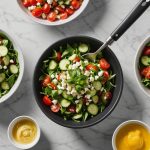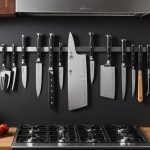Understanding Dietary Preferences in Kitchen Design
Creating a functional kitchen requires understanding various dietary preferences. Recognising these preferences enables consideration of both carnivorous and herbivorous needs, which differ significantly in how they guide kitchen design.
For carnivorous dietary needs, the emphasis is often on providing ample space for storing and preparing meats. Refrigeration plays a crucial role, so incorporating sufficient cooling units, or even a separate freezer, becomes essential. Moreover, countertops designed to handle raw ingredients safely, paired with durable cutting boards, are vital elements.
Also read : Elevate your cooking space: unlocking energy savings in smart kitchen designs during high demand hours
Conversely, herbivorous preferences focus on fresh produce. Implementing multiple preparation areas enhances efficiency, while a well-organized pantry or storage system ensures accessible placement of grains, legumes, and nuts.
The importance of accommodating various cooking styles cannot be overstated. A well-conceived kitchen design integrates diverse culinary apparatus, from steaming setups to grilling stations, enabling a broader range of cooking techniques.
Also to discover : Elevate your kitchen makeover: innovative and energy-saving lighting solutions for a brighter space
Incorporating flexible kitchen spaces to accommodate diverse culinary practices benefits everyone. By utilising modular storage solutions or adjustable shelving, homeowners can effortlessly adapt to any dietary shift. This flexibility not only enriches the culinary experience but also makes kitchens more adaptable to varied cooking methods.
Design Tips for a Versatile Kitchen
Creating a flexible and efficient kitchen design hinges on the effective integration of multi-functional spaces. Let’s explore some layout considerations to keep in mind.
Open Concept Layout
An open concept layout enhances connectivity between the kitchen and adjacent living areas. This design eliminates barriers, fostering interaction and fluidity. It can make smaller spaces feel larger and more inviting by allowing light to flow and unveiling sightlines. Consider incorporating transparent materials like glass to maintain openness while still defining spaces.
Zoning for Cooking Styles
Thoughtful zoning caters to varied cooking styles, whether you’re preparing meals with meat or focusing on vegetarian dishes. Segmenting areas for specific tasks, such as chopping, mixing, or baking, optimizes efficiency. You might allocate a separate zone for bulky kitchen gadgets and another for spices and ingredients. Zoning encourages an organised culinary process, ultimately saving time and reducing stress.
Multi-functional Kitchen Islands
A multi-functional kitchen island serves as the heart of a versatile kitchen. It’s a staple that supports tasks like meal preparation, dining, and even work. Incorporating features like built-in stoves, extendable tables, or storage solutions enhances utility. An island isn’t just a workspace; it’s where functionality meets style, transforming a regular kitchen into a dynamic and vibrant space.
Effective Storage Solutions
Kitchen storage can dramatically transform the functionality of your space. Achieving an organized kitchen begins with understanding the various ingredients you accommodate, especially if you’re balancing meat and plant-based ingredients. Designating separate storage areas ensures that your ingredients retain their original flavors and characteristics.
One practical idea is to implement a labeled storage system. By clearly marking containers or shelves, you not only make it easier to locate items but also help in maintaining order, which is essential for those with specific dietary restrictions. Labels could include information on the ingredient type, purchase date, or even dietary information, catering to everyone’s dietary needs efficiently.
Don’t overlook the power of vertical space and drawers. These areas are often underutilized, yet they can hold a significant amount of kitchen essentials. Vertical storage solutions like racks and tall shelving units can keep your items within reach without consuming valuable counter space. Drawer organizers are essential to separate utensils and small items, adding another layer of efficiency to your kitchen.
Incorporating these storage ideas will make your cooking environment more streamlined and tailored to your specific needs, ultimately enhancing both the functionality and aesthetic of your kitchen.
Key Appliances and Tools for Diverse Diets
Navigating the complexities of a diverse diet requires a kitchen well-equipped with the right kitchen appliances and cooking tools. Here, we explore essential and versatile kitchen devices that cater to both carnivorous and herbivorous preferences.
Essential Cooking Appliances
Kitchen appliances form the backbone of any culinary journey, providing the foundation for both simple and elaborate meals. For those who enjoy hearty meats, a reliable oven or slow cooker is indispensable. These appliances ensure that meats are cooked evenly and maintain their flavors. For plant-based enthusiasts, a high-performance blender is a must-have. It offers the versatility to create everything from smoothies to nut butters, accommodating a range of dietary preferences with ease.
Multi-tool Kitchen Gadgets
Streamlining your kitchen space while maintaining functionality is achievable with versatile kitchen equipment. Gadgets like food processors, which chop, slice, and puree, reduce the need for multiple devices, saving space and time. Similarly, immersion blenders simplify the process of making soups, sauces, and even creams, offering a multi-functional solution without cluttering your kitchen.
Specialized Cooking Equipment
For more niche culinary pursuits, investing in specialized cooking equipment can elevate your cooking experience. Carnivores might appreciate a quality grill for perfectly seared steaks, while herbivores can benefit from a dedicated vegetable steamer to preserve nutrients and flavor profiles. These premium tools enable precise cooking tailored to specific dietary needs, enhancing the overall quality of home-prepared meals.
Examples of Dynamic Kitchens
Exploring a variety of kitchen design examples can provide ample culinary inspiration for both budding chefs and seasoned cooks alike. One innovative approach is designing kitchens that cater to both vegetarian and meat eaters. This ensures seamless preparation regardless of dietary preferences, and promotes a cooperative cooking environment.
Case studies showcase creative solutions that homeowners adopt to accommodate diverse culinary needs. For instance, families might opt for separate food preparation stations. This can take the form of dual countertops, where one side is dedicated to plant-based meals and the other to non-vegetarian dishes. By doing so, it becomes easier to manage dietary requirements without cross-contamination or hassle.
Other homeowners embrace technology to enhance kitchen design examples. Smart appliances, such as refrigerators with custom temperature zones, ensure the freshness of various ingredients. Induction hobs, known for their precise heat control, further elevate cooking efficiency. These examples highlight thoughtful approaches individuals take to refine their cooking spaces.
Successful design case studies serve as proof that a dynamic kitchen accommodates various culinary preferences. By offering a range of designs that inspire creativity and practicality, they affirm that a well-organized kitchen enhances everyday cooking experiences. Understanding different approaches to kitchen layouts ultimately leads to tailored, more effective culinary environments.
Recipes and Techniques for Everyone
Creating meals that cater to a variety of dietary preferences can be a delightful challenge. The key lies in versatile recipes that can be easily adapted. For instance, a mushroom risotto can be a hearty option for vegetarians while adding chicken or shrimp transforms it into a dish for meat lovers. These adaptable recipes ensure that everyone at your table has something to enjoy.
Understanding fundamental cooking techniques can significantly enhance your culinary skills. Techniques such as roasting, sautéing, and grilling can be applied to both meat and plant-based ingredients. For example, roasting vegetables like carrots and Brussels sprouts alongside a chicken can produce a well-rounded meal.
Inclusive meal planning is another essential for any home cook. When hosting, understanding basic preferences—such as vegetarian, vegan, or gluten-free—helps in designing a menu that accommodates everyone. It’s useful to prepare dishes that can be altered at the last minute, such as pasta with separate sauces or customizable stir-fries. This ensures you can quickly provide alternatives without compromising taste or presentation.
For those looking to seamlessly integrate different dietary needs, pre-preparation and creative cooking techniques are essential tools in the kitchen. Embrace these methods, and you’ll find hosting to be an enjoyable experience for all.











